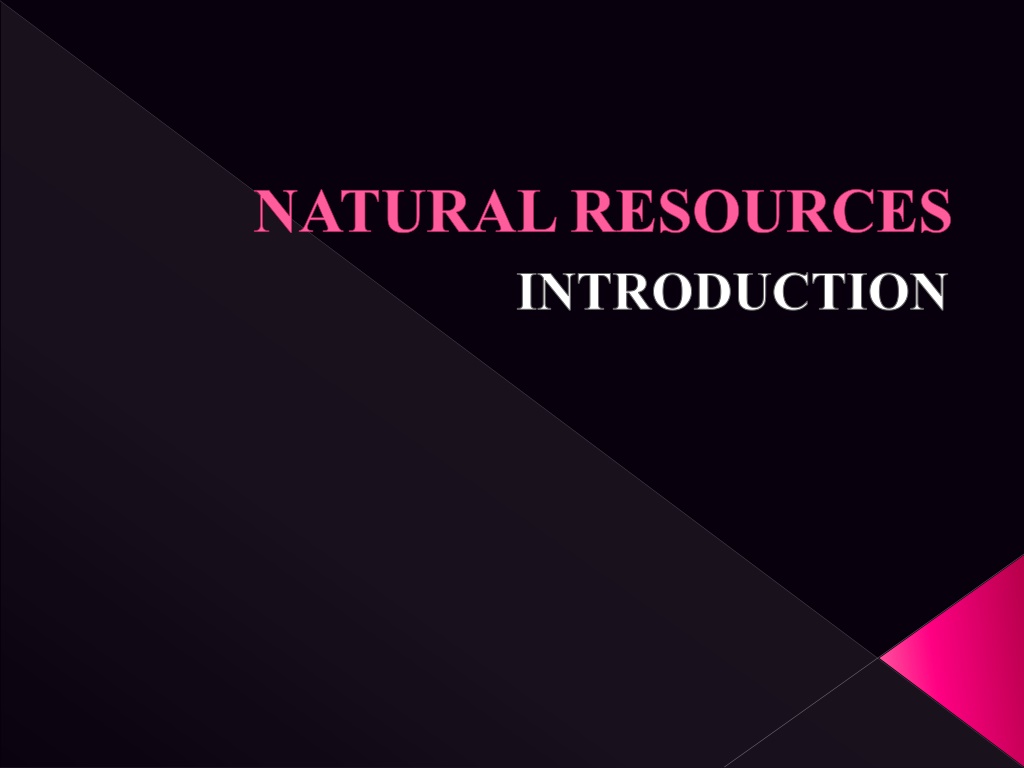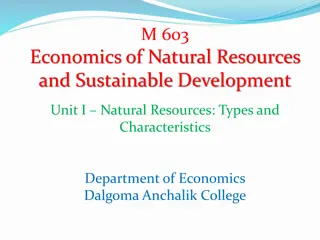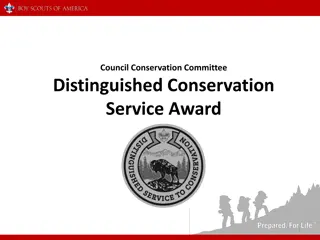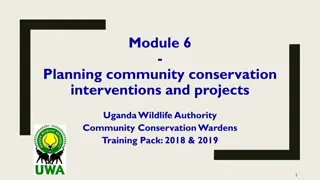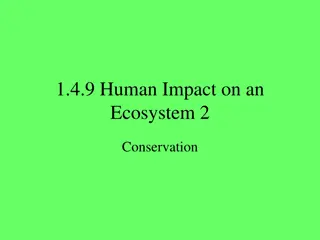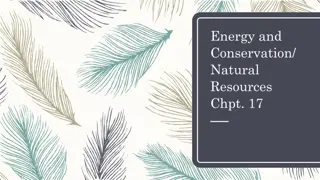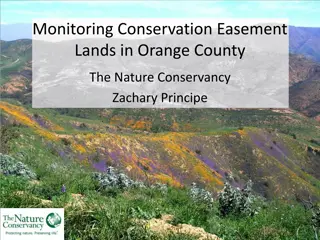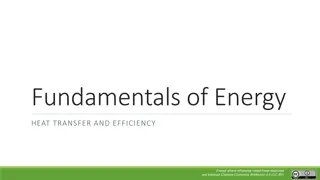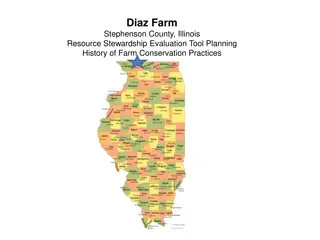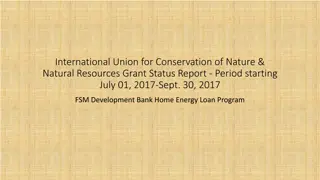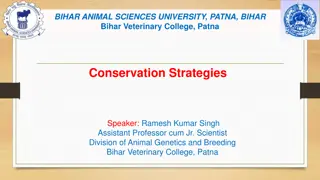Understanding Natural Resources: Types and Conservation
Natural resources play a crucial role in sustaining life on Earth, encompassing elements like water, air, soil, minerals, and more. These resources can be classified into renewable and non-renewable categories, with the former being replenishable through natural cycles and the latter being finite and irreplaceable. Renewable resources can reproduce and recycle, while non-renewable resources, like fossil fuels, are consumed once and gone forever. Conserving and managing these resources are essential for the well-being of current and future generations.
Uploaded on Sep 18, 2024 | 0 Views
Download Presentation

Please find below an Image/Link to download the presentation.
The content on the website is provided AS IS for your information and personal use only. It may not be sold, licensed, or shared on other websites without obtaining consent from the author. Download presentation by click this link. If you encounter any issues during the download, it is possible that the publisher has removed the file from their server.
E N D
Presentation Transcript
NATURAL RESOURCES INTRODUCTION
Resources does not refer to a thing or a substance but to a function which a thing or substance may perform or to an operation in which it may take part namely the function or operation of attaining a given end such as satisfying a want. Resource, therefore, means to attain given ends. The aspect of satisfaction is so important that we consider a thing or substance resource so long it meets our needs. Life on this planet depends upon a large number of things and services provided by the nature, which are known as Natural Resources. Thus water, air, soil, minerals, coal, forests, crops and wild life are all examples of natural resources.
Natural Resources A natural resource is defined as a form of energy and/or matter which is essential for the functioning of organisms, populations and ecosystems. Life on our planet earth depends upon a large number of things and services provided by the nature, which are known as natural resources. Water, air, soil, minerals, coal, forests, crops and wild life are all the examples of natural resources.
Classification of Natural Resources According to Odum (1971), Natural resources can be divided into two categories such as Renewable Non Renewable resources
RENEWABLE RESOURCES The resources that can be replenished through rapid natural cycles are known as renewable resource. These resources are able to increase their abundance through reproduction and utilization of simple substances. Some examples of renewable resources though they do not have life cycle but can be recycled are wood and wood-products, pulp products, natural rubber, fibers and leather.
Non-Renewable Resources The resources that cannot be replenished through natural processes are known as non- renewable resources. These are available in limited amounts, which cannot be increased. Once a non-renewable resource is consumed, it is gone forever. Then we have to find a substitute for it or do without it.
Non-renewable resources can further be divided into two categories Re-cycleable These are non-renewable resources, which can be collected after they are used and can be recycled. These are mainly the non-energy mineral resources, which occur in the earth s crust (e.g. ores of aluminium, copper, mercury etc.) Non-re cycleable These are non-renewable resources, which cannot be recycled in any way. Examples of these are fossil fuels and uranium, which provide 90 per cent of our energy requirements
Classify resources into biotic and abiotic resources Biotic resources These are living resources (e.g. forest, agriculture, fish andwild life) that are able to reproduce or replace them and to increase Abiotic resources These are non-living resources (e.g. petrol, land, minerals etc.) that are not able to replace themselves or do so at such a slow rate that hey are not useful to consider them in terms of the human life times.
Following are some examples of the major natural resources: Forest resources Water resources Mineral resources Food resources Energy resources Land resources
FOREST RESOURCES It is a dense growth of trees, together with other plants, covering a large area of land. Forests are one of the most natural resources on this earth. Covering the earth like a green blanket these forests innumerable material goods, but also provide several environmental services which are essential for life. not only produce
USES OF FORESTS Forests provide us a large number of commercial goods which include timber, firewood, pulpwood, food items, gum, resins, non-edible oils, rubber, fibers, lac, bamboo canes, fodder, medicine, drugs and many more items, the total of which is estimated to be more than $ 300 billion per year. Half of the timber cut each year is used as fuel for heating and cooking. One third of the wood harvest is used for building materials as lumber, plywood and hardwood, particle board and chipboard.
Ecological Uses The ecological services provided by our forests may be summed up as follows: Reducing global warming : The main greenhouse gas carbon dioxide (CO2)is absorbed by the forests as a raw material for photosynthesis. Wild life habitat : Forests are the homes of millions of wild animals and plants. About 7 million species are found in the tropical forests alone. Soil Conservation : Forests bind the soil particles tightly in their roots and prevent soil erosion. They also act as windbreaks.
DEFORESTATION The total forest area of the world in 1990 was estimated to be 7000 million hectares which was reduced to 2890 million hectares in 1975 and fell down to just 2300 million hectares by 2000. Deforestation rate is relatively less intemperate countries, but it is very alarming in tropical countries where it is as high as 40-50 percent and at the present rate is it estimated that in the next 60years we would lose more than 90 percent of our tropical forests. The forested area in India seems to have stabilized since 1982 with about 0.04%decline annually between 1982- 90. FAO (1983) estimated that about 1.44 mhectares of land were brought under afforestation during this period leading to stabilization.
Major causes of Deforestation Shifting cultivation There are an estimated 300 million people living as shifting cultivators who practice slash and burn agriculture and are supported so clear more than 5 lakh ha of forests for shifting cultivation annually. Fuel requirements Increasing demands for fuel wood by the growing population in India alone has shooted up to 300-500 million tons in 2001 as compared to just 65 million tons during independence, thereby increasing the pressure on forests Raw materials for industrial use Wood for making boxes, furniture, railway-sleepers, plywood, match boxes, pulp for paper industry etc
WATER RESOURCES It exists as a liquid over a wide range of temperature i.e. from 0 to 100 C. It has the highest specific heat, due to which it warms up and cools down very slowly without causing shocks of temperature jerks to the aquatic life. It has high latent heat of vaporization. Hence, it takes huge amount energy for getting vaporized. That s why it produces a cooling effect as it evaporates
The water from various moist surfaces evaporates and fall again on the earth in the form of rain or snow and passes through living organisms and ultimately returns to oceans. Solar energy drives the water cycle by evaporating it from various bodies, which subsequently return through rainfall or snow. Plants too play a very vital role by absorbing the groundwater from the soil and releasing it into the atmosphere by process of transpiration. Global distribution of water resources is quite uneven depending upon several geographic factors.
Groundwater About resources is in the form of groundwater and it is about 35-50 times that of surface water supplies. 9.86% of the total fresh water Effects of groundwater usage: Subsidence Lowering of water table Water logging
MINERAL RESOURCES: Minerals are naturally occurring, inorganic, crystalline solids having definite characteristic physical properties. chemical composition and There are thousands of minerals occurring in different parts of the world. However, most of the rocks, we see everyday are just composed of few common minerals like quartz, feldspar, biotite etc. These minerals in turn are composed of some elements like silicon, oxygen, iron etc. Minerals are generally used for development of industrial plants, generation of energy, construction, equipments and armament for defence, transportation means, medical system, communication, jewellery- gold, silver etc.
FOOD RESOURCES: There are thousands of edible plants and animals over the world out of which only about three dozen types constitute major food of humans. The main food resources include wheat, rice, maize, potato, barley, oats etc. about twenty or so common fruits and vegetables, milk, meat, fish and seafood. World food problems: Every year food problem is killing as many people as were killed by the atomic bomb dropped on Hiroshima during World War II. This shows that there is drastic need to increase food production, equitably distribute it and also to control population growth.
Our food problems are directly related to population. Because of overgrazing the agricultural land gets affected as follows, it results into: Land degradation Soil erosion Loss of useful species Agriculture also makes impact on the usage of land generally as follows: Deforestation Soil Erosion Depletion of nutrients
ENERGY RESOURCES Energy consumption of a nation is usually considered as an index of its development. This is because almost all the development activities are directly or indirectly dependent upon energy. Renewable energy resources must be preferred over the non- renewable resources. This will seek to end the energy crisis which the world is facing today. It is inevitable truth that now there is an urgent need of thinking in terms of alternative sources of energy, which are also termed as non-conventional energy sources which include: 1. solar energy- made up equipments such has solar heat collectors, solar cells, solar cooker, solar water heater, solar furnace, solar power plants are must. Wind energy non renewable energy sources include coal, petroleum, natural gas, nuclear energy.
LAND RESOURCES: Land as a resource: Land is a finite and valuable resource upon which we depend for our food, fiber and fuel wood, the basic amenities of life. Soil is also a valuable resource.
Land Degradation Because of increasing of population growth the demands for arable land for producing food and fuel wood is also increasing. Hence there is more and more pressure on the limited land resources which are getting degraded due to over-exploitation. Soil erosion, water logging, salinization and contamination of the soil with industrial wastes like fly-ash, press mud or heavy metals all cause degradation of land. Soil Erosion: Soil erosion means wearing away of soil. It defined as the movement of soil components, especially surface- litter and top soil from one place to another. It results in the loss of fertility. It basically of two types viz, normal erosion go geologic erosion and accelerated erosion. The agents that cause such erosion are- climatic agents and water induced erosion, biotic agents. Wind is also responsible for the land erosion through saltation, suspension and surface creep. In order to prevent soil erosion and conserve the soil the following conservation practices are employed: Conservational till farming. Contour farming Terracing Strip cropping Strip cropping Alley cropping Wind breaks or shelterbelts Water logging Landslides: Various anthropogenic activities like hydroelectric projects, large dams, reservoirs, construction of roads and railway lines, construction of buildings, mining etc. are responsible for clearing of large forested areas. Desertification: Desertification is a process whereby the productive potential of arid or semiarid lands falls by ten percent or more. Desertification is characterized by de vegetation and loss of vegetal over, depletion of groundwater, salinization and severe soil erosion.
